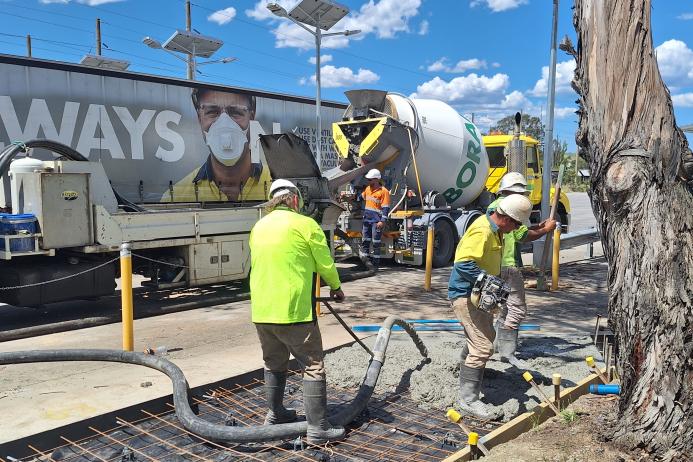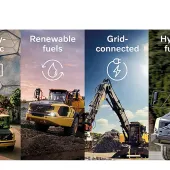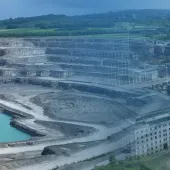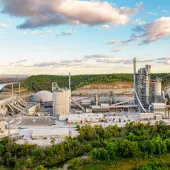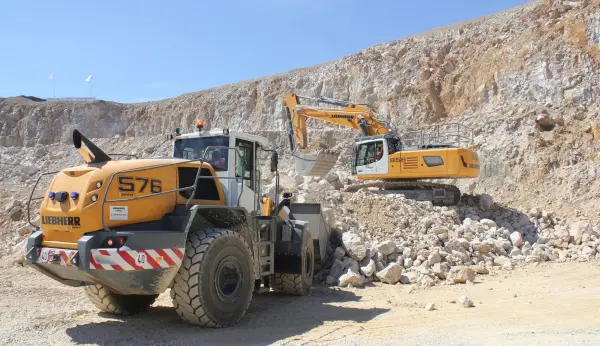Recarbonated concrete field trial success for Boral
Successful trial of concrete with recycled concrete aggregates recarbonated via carbon capture from cement plant
BORAL Ltd have successfully produced concrete made with recycled concrete aggregates that have been recarbonated via carbon capture technology from their integrated cement manufacturing plant.
The trial, the first of its kind in Australia, saw recycled concrete aggregates from Boral’s Widemere recycling facility used as feedstock to capture and permanently store CO2 from the flue gas diverted from Berrima Cement Works’ operations into its recently commissioned recarbonation-based carbon capture and storage (CCS) pilot plant. The recarbonated recycled aggregates resulting from this process were then used to partially replace natural coarse aggregates in a low-carbon concrete mix.
This milestone demonstrates a viable pathway for using products from recarbonation-based carbon capture technology, which Boral is currently trialling at their Berrima cement plant.
One of the unique properties of concrete is that it absorbs carbon dioxide through its service, life and end-of-life phases. This process – cement recarbonation – occurs over many years. At end of life, when structures containing concrete are demolished, the concrete is crushed, commonly into recycled concrete aggregates, and its exposed surface increases, accelerating the recarbonation rate. The recarbonation process at Berrima CCS plant accelerates the natural carbonation of recycled aggregates by exposing them to controlled process conditions.
Boral’s concrete field trial was conducted at their Maldon cement manufacturing facility. The trial and CCS pilot plant’s construction were jointly funded by the Federal Government’s Carbon Capture, Use and Storage (CCUS) Development Fund and Boral. The project involved replacing 50% of the natural coarse aggregates in Boral’s low-carbon Envisia concrete with recarbonated recycled aggregates.
The recarbonation CCS process offers a practical, low-cost solution for capturing and permanently storing carbon dioxide from cement manufacturing. Carbon capture, utilization and storage is a critical decarbonization lever for addressing process emissions, which account for approximately 65% of carbon emissions in cement production.
Dr Ali Nezhad, head of sustainability and innovation at Boral, said: ‘We’re proud to lead the development of utilization pathways for recarbonated concrete aggregates. Its successful use not only enhances the viability of recarbonation-based carbon capture technology but also offers the potential for a further reduction in the embodied carbon of concrete by replacing natural aggregates. The success of our carbon capture pilot plant at Berrima further validates the potential of recarbonation and underscores the importance of its broader recognition.’
Vik Bansal, chief executive officer and managing director of Boral, added: ‘At Boral, we are committed to a lower-carbon future, and we believe recarbonation will play an important role in decarbonizing the cement and concrete industry. The successful accelerated recarbonation of recycled concrete aggregates at our CCS pilot plant at Berrima and utilization of these aggregates in concrete further reinforce the potential of this technology.
‘Alongside our significant investments in alternative fuels and alternative materials to decarbonize our cement manufacturing operations in the short term, we remain committed to exploring technologies like carbon capture and storage as part of our long-term journey towards our net-zero ambition by 2050.’
As recognized in the Sixth Assessment Report of the United Nation’s Intergovernmental Panel on Climate Change (IPCC), carbon emissions from concrete and cement manufacturing are partially absorbed by concrete during the life cycle of concrete buildings and infrastructure. Studies estimate that the CO2 uptake through recarbonation of concrete could range from 20% to 55% of process CO2 emissions during cement manufacturing.

